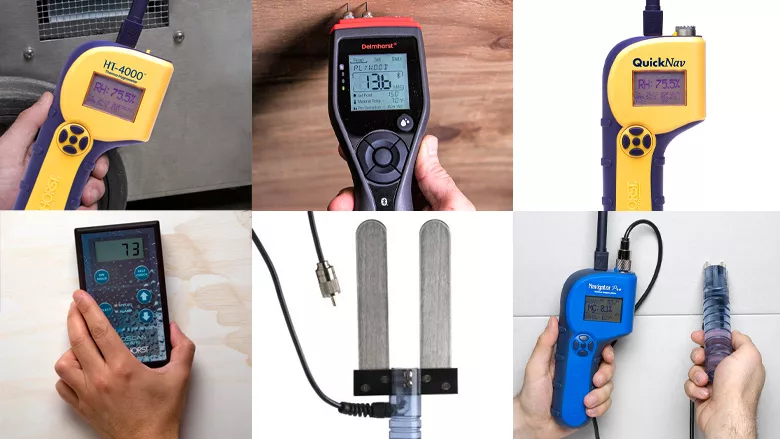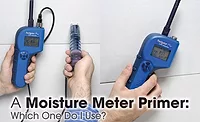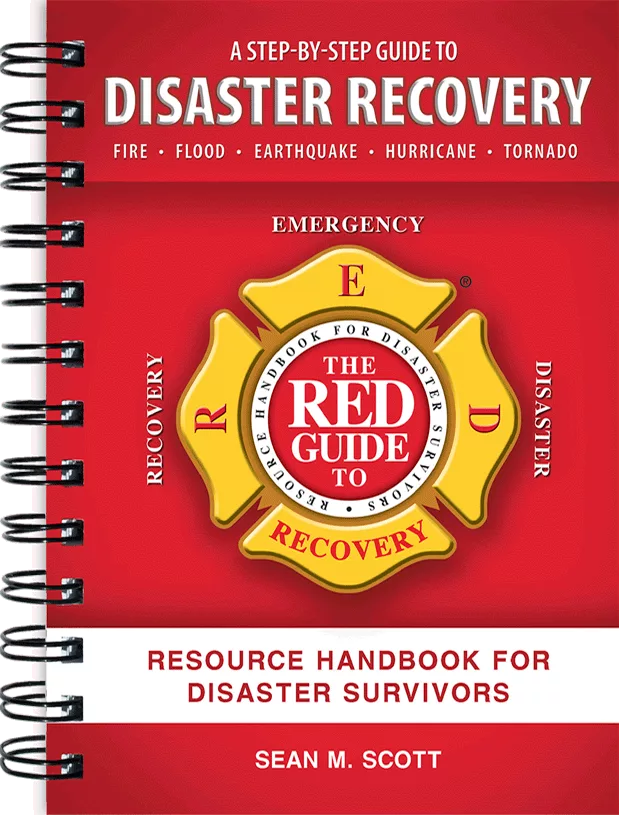A Few Tips for Restorers to Make the Most out of Your Moisture Meter

Photo credit: Delmhorst
Moisture Meters have long been essential in the wide array of tools required by water damage restoration techs, mold remediation and IAQ specialists, and any building or home inspector. The need for meters makes perfect sense when you consider the fact that, according to Forbes Advisor, moisture-related issues are the reason for 24% of property claims. Moisture is the single-most important factor affecting the building integrity and a primary element needed for mold, mildew and bacteria to thrive.
Industry professionals know that without a quality moisture meter, it is virtually impossible to properly survey the extent of the water intrusion, monitor the drying out of a structure and detect hidden moisture that can ultimately cause structural and health-related problems.
Industry standards (IICRC) call for using pin-less or non-invasive meters for a rapid investigation of the damage and to map out the structure. Then use the pin-type meters for the most reliable and repeatable means of measuring moisture in different building materials. Pin meters can be used with external electrodes that add versatility and convenience, depending on the material. It is the pin meter readings that are usually recorded for insurance purposes and inform over the course of drying so end-point decisions can be made. Using these two meters together, along with a professional grade thermo-hygrometer for psychometric values, will give you the best results.
Neither type moisture meter actually measures moisture, but they measure an electrical property of the material. Pin-less meters use RF and impedance technology to detect the presence of moisture. The meter’s sensor pad must be in full contact with the material being tested. The meter transmits and receives back a low frequency signal and outputs the difference between the two, as an indication of the moisture present. This is especially useful for meters that provide relative moisture levels (wet/dry) readings on building materials.
The convenience and efficiency of a pin-less meter is appealing. As with most measurement tools there are some important points to keep in mind when using them:
- Material surface should be smooth to ensure sensor contact
- Surface moisture generally skews the meter reading. This varies among the meters available, but one should understand the impact of surface moisture and how it affects the behavior of the specific meter
- Penetration depth is limited to about ½ to ¾ inch with most meters
- Hidden objects like electrical boxes, wires and metal studs can impact the readings.
- Hard to reach areas are just that – hard to reach.
Pin meters are based on conductance. Two electrode pins are driven into the material and the meter measures the resistance between them, as influenced by moisture present. The meter displays the %MC if on a calibrated scale, or a relative number that may be used for comparative, wet/dry readings. There is a well-defined, direct relationship between the moisture content of wood and its electrical resistance. This applies for drywall as well. Repeatable, relative readings can be obtained on virtually any hygroscopic building material.
The major limitation of a pin meter is that it cannot cover large areas quickly. Some have concern about leaving holes in the material. This is a non-issue when you consider the damage already present in a water damaged environment and the damage that may develop if moisture were left undetected.
The two integral contact pins on top of the meter cover many applications but pin meter versatility is highlighted by the external electrodes usually available. These tools provide further information about moisture conditions in less accessible areas.
- Slide Hammer Electrode - The contact pins are insulated except at the tip, providing more accurate discrimination among readings taken at different depths of penetration. This feature is useful for checking moisture in any structural wood member and allows you to penetrate through flooring to a wood-based subfloor. Before using, check that the contact pin retainers are tightened to insure good electrical contact. Also inspect the pins. If the insulation has worn off, replace them with new ones.
- Deep Wall Probe – Most feature 4”- 6” insulated pins for use on insulation behind drywall, or any application where deeper penetration is required. This probe is also an effective tool for checking synthetic stucco clad structures and roofing materials. As with the slide hammer, check the retainers and pins before using.
- Blade-type Electrode – This type of electrode is a great tool for measuring moisture behind trim and baseboard molding as well as under sill plates. It utilizes two blades that are insulated, but for the tips, and bent to an angle for ease of insertion. A flat blade version is ideal for checking moisture in books and documents.
Follow a few important steps before using either type of moisture meter:
Check the battery and calibration – Every tech needs to know their meter is working properly before starting a job. Many meters come with easy-to-use internal checks, but it’s always recommended to use an external standard that can be provided by the manufacturer to check the electrical calibration of your meter. It’s also advisable to check the accuracy of your RH/T sensor from time to time using an appropriate salt solution kit or a reference sensor that you keep on hand solely for calibration checks.
Review meter settings as applicable - Some meters are “point and shoot” in that they provide a raw reading only without the possibility to account for factors that affect accuracy. Others include settings that can enhance meter reading accuracy by giving the technician flexibility to apply meter reading corrections. These include settings for wood species and other materials, material temperature, and even a correction for using insulated or non-insulated contact pins. The pins’ correction is most relevant when testing wood.
Make sure you are on the correct meter scale – Meters are equipped with reading scales for as few as one or two, or as many as dozens of materials, mostly wood species. A source of confusion in the industry is the use of relative or reference scales, intended for use on materials where a quantitative %MC calibration is not available or even possible. These “arbitrary” scales vary from meters produced by different manufacturers. Some examples are 0-100, 0-300 and 0-1000. Regardless, readings are intended for benchmark and comparative purposes. Those in the low end of the scale indicate a “drier” condition; readings in the upper end of the scale indicate a higher moisture level in the material. Although a reference scale does not provide %MC, it is still quite useful to evaluate moisture conditions.
Be consistent – Whenever possible, use the same meter on the same project day after day. Like with most instrumentation, once you have had some time with a meter learning about its operation and how it behaves under certain conditions, you will come to rely on its performance with complete confidence.
Moisture meters are easier than ever to use and now with exciting Bluetooth connectivity, moisture meters offer great flexibility and customization. They are fast and accurate, and the information they provide will always be critical to making good drying decisions. Know the meter’s capabilities. Follow the manufacturers’ procedures and recommendations supported by your own knowledge and experience.Looking for a reprint of this article?
From high-res PDFs to custom plaques, order your copy today!








